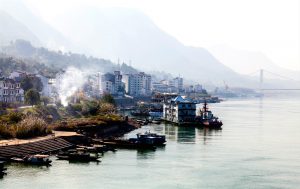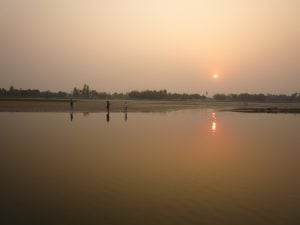In India 330 million people were affected by the 2015-16 drought. Women and children were among the most seriously affected, with increases in wasting among mothers, an increase in child labour and cases of trafficking and child labour in some of the drought-affected states, the white paper released at the recent meeting of the United Nations Convention to Combat Desertification (UNCCD) in September in New Delhi says. The paper was released on 11 September that was dedicated to focussed discussions on drought, a topic that is increasingly being pushed by Africa in recent UNCCD meetings.
In Pakistan the drought from 1998-2002 was considered the worst in 50 years, impacting over 80% of apple trees and orchards in the province of Balochistan. The drought also resulted in famine, slowed economic growth, raised food prices, and spread diseases and malnutrition in the province, it observes.
Similarly, Afghanistan suffered three consecutive years of drought around 2011, leading to near total failure of rainfed agriculture, reduction in irrigated farm production and decimation of livestock.
Bangladesh has been impacted by droughts and food insecurity in the northern region, coupled with poor coping strategies, says the paper. And in Sri Lanka, a severe drought followed by heavy rainfalls reduced the production of rice, the country’s staple food, by almost 40% in 2017, threatening the food security of about 900,000 people.
Severe drought has not spared Southeast Asia and China either. In China, the Inner Mongolia Autonomous Region, Liaoning and Jilin provinces suffered the effects of severe droughts. And in SE Asia, several countries were affected by the 2015-2017 drought.
In Vietnam, the 2016 drought was the worst in nearly a century, impacting not only food production and livelihoods, but also intensifying salt water intrusion in coastal areas.
The 2015-17 drought hit 17 provinces in the Philippines, led to water shortages in 146 villages in Myanmar, and triggered fires that destroyed several hundred hectares of crops in early 2016 in the Malaysian province of Sabah, the paper says.
With climate change projected to increase the occurrence and intensity of droughts in many parts of the world, especially in drylands, national drought policies should be integrated with climate change adaptation plans and sustainable development strategies, the white paper suggests.
However, preparing national drought policies faces several challenges. These include political will as governments are reluctant to declare a drought in advance; coordination between various government agencies; availability of adequate resources in terms of institutions, human and technical capacity, and linking science to policy and transmitting information to policy makers.
Winter drought in Hindu Kush Himalayas
The white paper’s grim tidings come at a time when worries over a lingering winter drought have begun to grip scientists and policy makers in the Hindukush Himalayan (HKH) countries.
“Poor winter rain increases dryness”, K J Ramesh, former director general of the Indian Meteorological Department told journalists at a media workshop conducted by the Centre for Science and Environment, New Delhi in September. Data presented by Ramesh shows that from January to march 2018, there were 43 extremely dry districts in India, 110 severely dry, 113 moderately dry and 206 mildly dry.
In 2018, the eastern parts of Nepal were hit by drought in the winter “The Hindukush Himalaya region is a drought-prone area,” Mir Matin, theme leader for geospatial solutions at the International Centre for Integrated Mountain Development (ICIMOD), Kathmandu, told a regional workshop on drought, held in Kathmandu in November 2018. “Droughts are occurring at high frequency,” he said.
The problems in the HKH region are further compounded by absence of system for regional drought monitoring; low capacity and experience in forecasting and monitoring precipitation (rain and snow); and inadequate infrastructure.
A three-year field study, initiated in 2015 and coordinated by the ICIMOD in the Indus, Gandaki, Ganga and Brahmaputra river basins found that failure of winter crop has forced subsistence farmers, especially men, to search for alternative incomes and migrate. This increases the work load of women and children, besides making them vulnerable to exploitation and abuse, gender and adaptation specialist Pranita Bhushan Udas from ICIMOD reported at the workshop.
“There is a tendency to assume that drought is linked to the South Asian monsoon and ends thereafter, and one does not realize the continued importance of winter rains for the region’s agriculture, Udas pointed out. Her team found that farmers in Nepal felt they could somehow cope with monsoon-related drought, but a winter drought that follows is a double whammy for them.
In such a scenario, measures to predict drought and a gender-sensitive support system to cope with drought could reduce the vulnerability of people, especially women,” she added.
At the ICIMOD workshop, scientists from HKH countries that were struggling to cope with both summer and winter drought said that these countries were using remote sensing satellite data under several projects aided by USAID and National Aeronautics and Space Administration (NASA) in Afghanistan, Pakistan, Nepal and Bangladesh. Data from LANDSAT, MODIS or CHIRPS satellites is being used to monitor droughts and crops. Similarly a USAID project in lower Mekong valley has developed a regional drought monitoring and forecast system that was rolled out in April 2018.
There is an urgent need for a reliable early warning systems for crop conditions such as soil moisture, and advance estimates of in-season crop yields, scientists said at the Nepal meeting.
There are several technical challenges too that need to overcome — lack of data and data reliability; inadequate ground data to validate the forecast models developed, inconsistent data sets, and need for different indices for different crops.
“Forecast technology has improved tremendously for cyclones, but not for droughts,” said Basanta Shreshtha, director of strategic cooperation and ICIMOD. There are “too many uncertainties in forecasts compared to floods,” agreed Hand Guttman, the executive director of the Asian Disaster Preparedness Centre, Bangkok.
UNCCD’s drought initiatives
International agencies have begun to pitch in with help with remote sensing data and drought prediction initiatives.
In July 2019 ICIMOD, along with its partners and the International Maize and Wheat Improvement Centre in Mexico, launched a web-based Regional Drought Monitoring and Outlook System for South Asia – an integrated information platform linking weather and climate data with agriculture practices in South Asia. The system provides multiple indices for droughts and seasonal weather outlooks, besides maps and baseline.
UNCCD’s Science-Policy Interface group comprising scientists, which guides the CST, launched a two-year Drought Initiative in 2018 with a focus on drought preparedness systems, regional efforts to reduce drought vulnerability and risk; and preparing a toolbox to boost the resilience of people and ecosystems to drought.
In August 2019, it also brought out a report on the land-drought nexus that recommends land-based interventions, such as improved and sustainable soil, water and crop management, to reduce the effects of drought.
At the Delhi meeting, the UNCCD lead scientist Barron Jospeh Orr released a drought tool box with a set of three broad indicators. The first two are a drought hazard indicator that tracks the proportion of land area out of total land area under drought; and a drought exposure indicator that tracks the proportion of people exposed to drought. The third is a drought vulnerability indicator that tracks drought vulnerability of communities.
The first two set of indicators are relatively easy to measure and report, said Carl Fiati, chair of the Science and Technology Committee (STC) at the Delhi meeting. But the third is a complex indicator that factors in socio-economic conditions and needs to be worked on.
![<p>Young girls at a dug well in a remote village near Thano Bula Khan in Jamshoro Dirsticrt near Karachi. Kohistan is an arid region and suffering with severe droughts for many years [image by: Zulfiqar Kunbhar]</p>](https://dialogue.earth/content/uploads/2018/03/Pic-01.jpg)







